child restraint Abarth 500 2020 Owner handbook (in English)
[x] Cancel search | Manufacturer: ABARTH, Model Year: 2020, Model line: 500, Model: Abarth 500 2020Pages: 196, PDF Size: 3.53 MB
Page 62 of 196
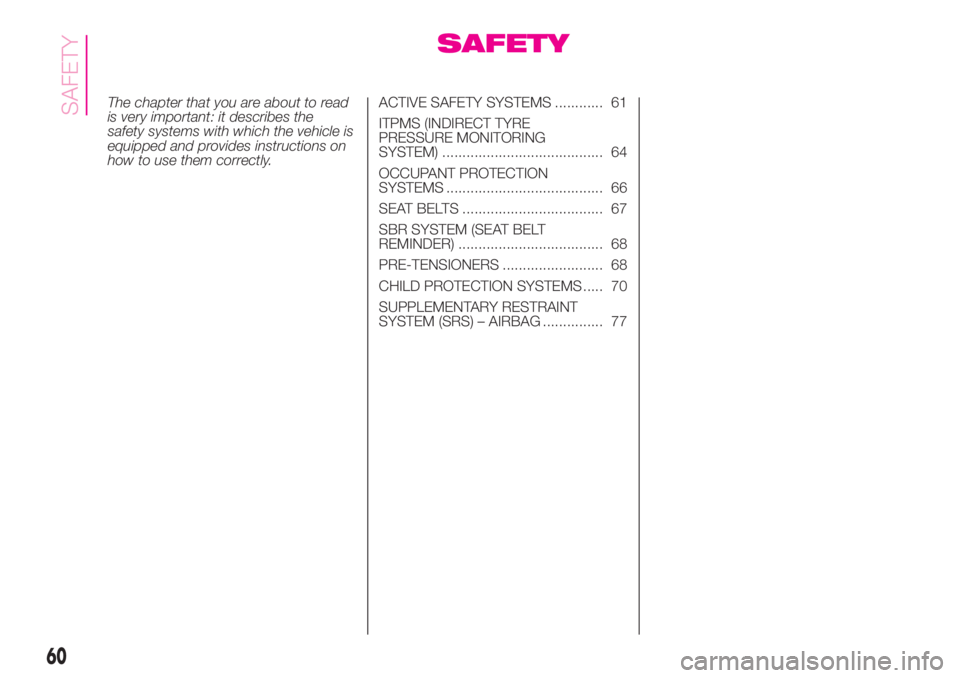
SAFETY
The chapter that you are about to read
is very important: it describes the
safety systems with which the vehicle is
equipped and provides instructions on
how to use them correctly.ACTIVE SAFETY SYSTEMS ............ 61
ITPMS (INDIRECT TYRE
PRESSURE MONITORING
SYSTEM) ........................................ 64
OCCUPANT PROTECTION
SYSTEMS ....................................... 66
SEAT BELTS ................................... 67
SBR SYSTEM (SEAT BELT
REMINDER) .................................... 68
PRE-TENSIONERS ......................... 68
CHILD PROTECTION SYSTEMS ..... 70
SUPPLEMENTARY RESTRAINT
SYSTEM (SRS) – AIRBAG ............... 77
60
SAFETY
Page 68 of 196
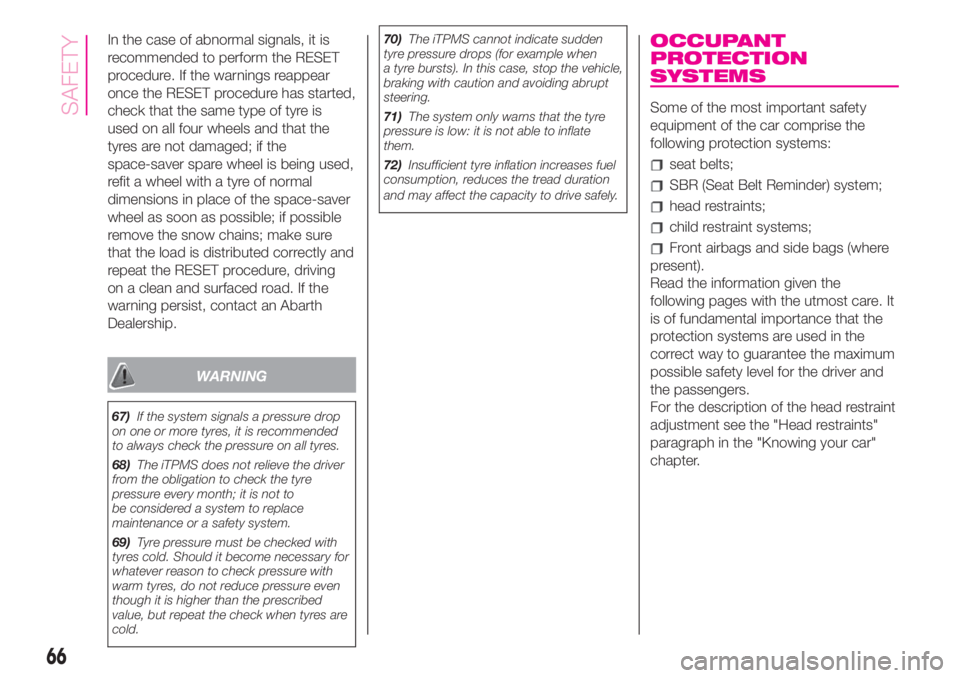
In the case of abnormal signals, it is
recommended to perform the RESET
procedure. If the warnings reappear
once the RESET procedure has started,
check that the same type of tyre is
used on all four wheels and that the
tyres are not damaged; if the
space-saver spare wheel is being used,
refit a wheel with a tyre of normal
dimensions in place of the space-saver
wheel as soon as possible; if possible
remove the snow chains; make sure
that the load is distributed correctly and
repeat the RESET procedure, driving
on a clean and surfaced road. If the
warning persist, contact an Abarth
Dealership.
WARNING
67)If the system signals a pressure drop
on one or more tyres, it is recommended
to always check the pressure on all tyres.
68)The iTPMS does not relieve the driver
from the obligation to check the tyre
pressure every month; it is not to
be considered a system to replace
maintenance or a safety system.
69)Tyre pressure must be checked with
tyres cold. Should it become necessary for
whatever reason to check pressure with
warm tyres, do not reduce pressure even
though it is higher than the prescribed
value, but repeat the check when tyres are
cold.70)The iTPMS cannot indicate sudden
tyre pressure drops (for example when
a tyre bursts). In this case, stop the vehicle,
braking with caution and avoiding abrupt
steering.
71)The system only warns that the tyre
pressure is low: it is not able to inflate
them.
72)Insufficient tyre inflation increases fuel
consumption, reduces the tread duration
and may affect the capacity to drive safely.
OCCUPANT
PROTECTION
SYSTEMS
Some of the most important safety
equipment of the car comprise the
following protection systems:
seat belts;
SBR (Seat Belt Reminder) system;
head restraints;
child restraint systems;
Front airbags and side bags (where
present).
Read the information given the
following pages with the utmost care. It
is of fundamental importance that the
protection systems are used in the
correct way to guarantee the maximum
possible safety level for the driver and
the passengers.
For the description of the head restraint
adjustment see the "Head restraints"
paragraph in the "Knowing your car"
chapter.
66
SAFETY
Page 72 of 196
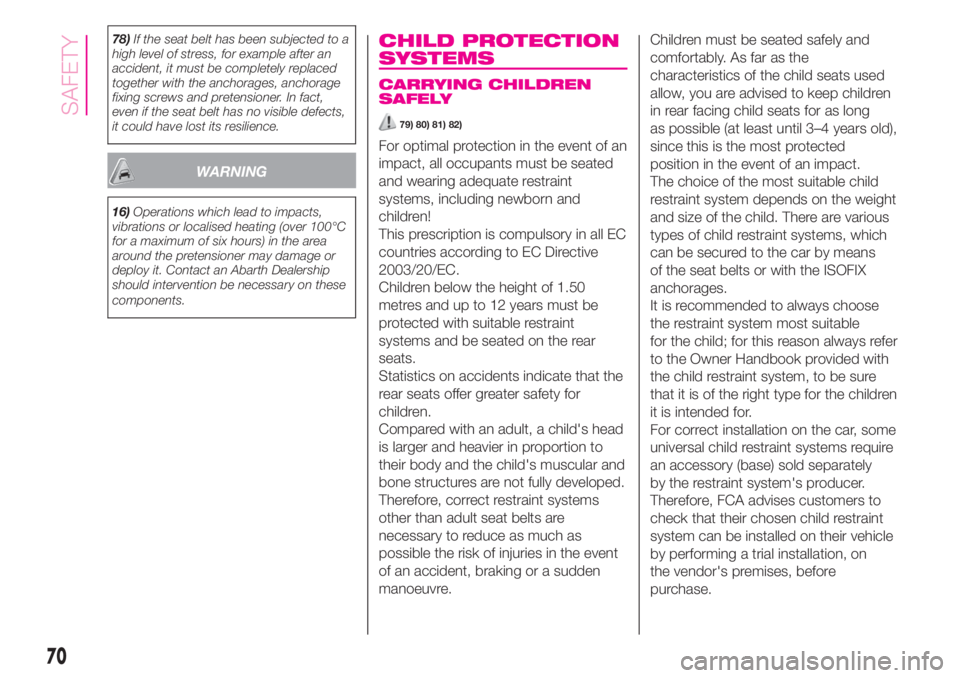
78)If the seat belt has been subjected to a
high level of stress, for example after an
accident, it must be completely replaced
together with the anchorages, anchorage
fixing screws and pretensioner. In fact,
even if the seat belt has no visible defects,
it could have lost its resilience.
WARNING
16)Operations which lead to impacts,
vibrations or localised heating (over 100°C
for a maximum of six hours) in the area
around the pretensioner may damage or
deploy it. Contact an Abarth Dealership
should intervention be necessary on these
components.
CHILD PROTECTION
SYSTEMS
CARRYING CHILDREN
SAFELY
79) 80) 81) 82)
For optimal protection in the event of an
impact, all occupants must be seated
and wearing adequate restraint
systems, including newborn and
children!
This prescription is compulsory in all EC
countries according to EC Directive
2003/20/EC.
Children below the height of 1.50
metres and up to 12 years must be
protected with suitable restraint
systems and be seated on the rear
seats.
Statistics on accidents indicate that the
rear seats offer greater safety for
children.
Compared with an adult, a child's head
is larger and heavier in proportion to
their body and the child's muscular and
bone structures are not fully developed.
Therefore, correct restraint systems
other than adult seat belts are
necessary to reduce as much as
possible the risk of injuries in the event
of an accident, braking or a sudden
manoeuvre.Children must be seated safely and
comfortably. As far as the
characteristics of the child seats used
allow, you are advised to keep children
in rear facing child seats for as long
as possible (at least until 3–4 years old),
since this is the most protected
position in the event of an impact.
The choice of the most suitable child
restraint system depends on the weight
and size of the child. There are various
types of child restraint systems, which
can be secured to the car by means
of the seat belts or with the ISOFIX
anchorages.
It is recommended to always choose
the restraint system most suitable
for the child; for this reason always refer
to the Owner Handbook provided with
the child restraint system, to be sure
that it is of the right type for the children
it is intended for.
For correct installation on the car, some
universal child restraint systems require
an accessory (base) sold separately
by the restraint system's producer.
Therefore, FCA advises customers to
check that their chosen child restraint
system can be installed on their vehicle
by performing a trial installation, on
the vendor's premises, before
purchase.
70
SAFETY
Page 73 of 196
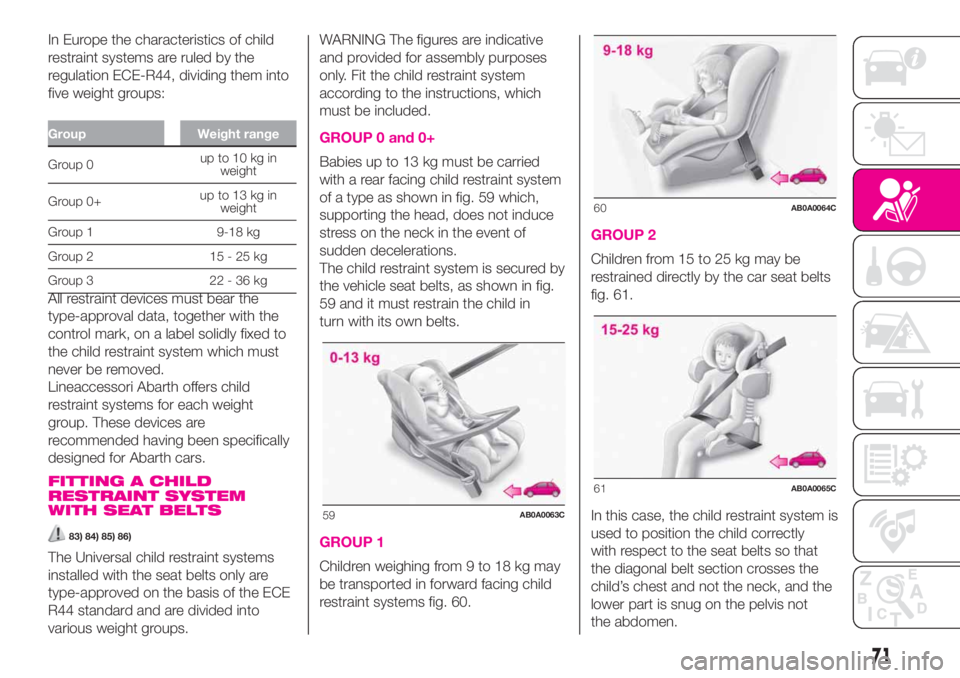
In Europe the characteristics of child
restraint systems are ruled by the
regulation ECE-R44, dividing them into
five weight groups:
Group Weight range
Group 0up to 10 kg in
weight
Group 0+up to 13 kg in
weight
Group 1 9-18 kg
Group 2 15 - 25 kg
Group 3 22 - 36 kg
All restraint devices must bear the
type-approval data, together with the
control mark, on a label solidly fixed to
the child restraint system which must
never be removed.
Lineaccessori Abarth offers child
restraint systems for each weight
group. These devices are
recommended having been specifically
designed for Abarth cars.
FITTING A CHILD
RESTRAINT SYSTEM
WITH SEAT BELTS
83) 84) 85) 86)
The Universal child restraint systems
installed with the seat belts only are
type-approved on the basis of the ECE
R44 standard and are divided into
various weight groups.WARNING The figures are indicative
and provided for assembly purposes
only. Fit the child restraint system
according to the instructions, which
must be included.
GROUP 0 and 0+
Babies up to 13 kg must be carried
with a rear facing child restraint system
of a type as shown in fig. 59 which,
supporting the head, does not induce
stress on the neck in the event of
sudden decelerations.
The child restraint system is secured by
the vehicle seat belts, as shown in fig.
59 and it must restrain the child in
turn with its own belts.
GROUP 1
Children weighing from 9 to 18 kg may
be transported in forward facing child
restraint systems fig. 60.
GROUP 2
Children from 15 to 25 kg may be
restrained directly by the car seat belts
fig. 61.
In this case, the child restraint system is
used to position the child correctly
with respect to the seat belts so that
the diagonal belt section crosses the
child’s chest and not the neck, and the
lower part is snug on the pelvis not
the abdomen.
59AB0A0063C
60AB0A0064C
61AB0A0065C
71
Page 74 of 196
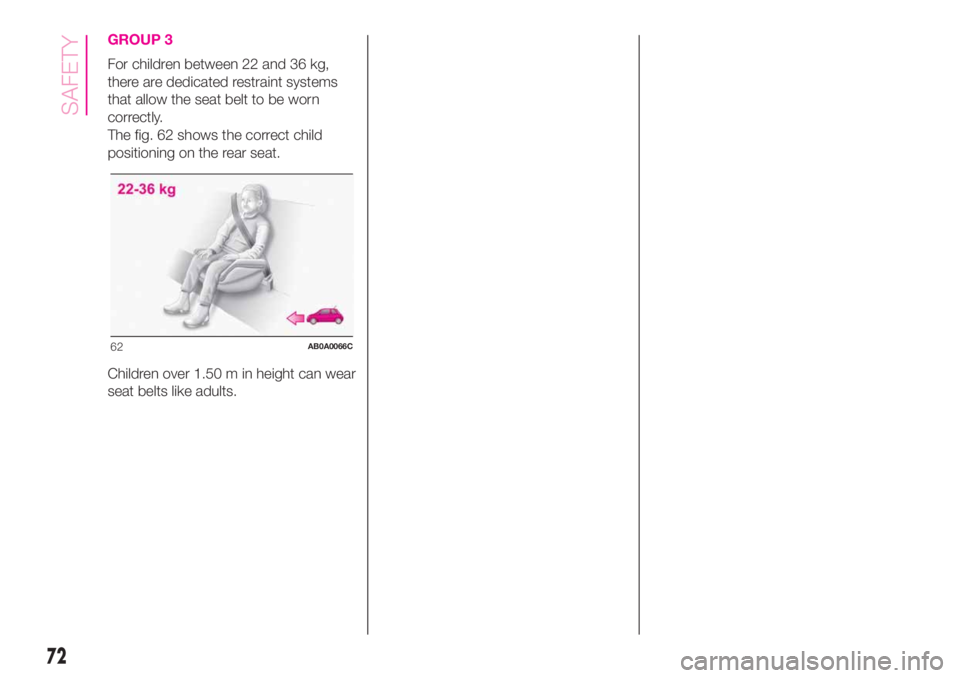
GROUP 3
For children between 22 and 36 kg,
there are dedicated restraint systems
that allow the seat belt to be worn
correctly.
The fig. 62 shows the correct child
positioning on the rear seat.
Children over 1.50 m in height can wear
seat belts like adults.
62AB0A0066C
72
SAFETY
Page 75 of 196
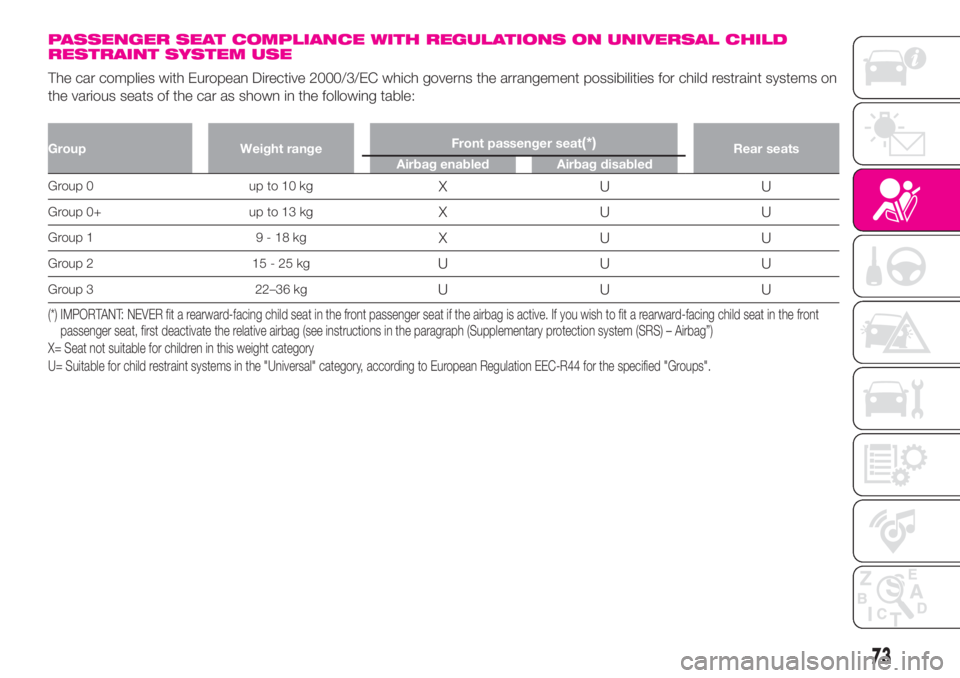
PASSENGER SEAT COMPLIANCE WITH REGULATIONS ON UNIVERSAL CHILD
RESTRAINT SYSTEM USE
The car complies with European Directive 2000/3/EC which governs the arrangement possibilities for child restraint systems on
the various seats of the car as shown in the following table:
Group Weight rangeFront passenger seat(*)Rear seats
Airbag enabled Airbag disabled
Group0 upto10kgXUU
Group 0+ up to 13 kgXUU
Group 1 9 - 18 kgXUU
Group 2 15 - 25 kgUUU
Group 3 22–36 kgUUU
(*) IMPORTANT: NEVER fit a rearward-facing child seat in the front passenger seat if the airbag is active. If you wish to fit a rearward-facing child seat in the front
passenger seat, first deactivate the relative airbag (see instructions in the paragraph (Supplementary protection system (SRS) – Airbag”)
X= Seat not suitable for children in this weight category
U= Suitable for child restraint systems in the "Universal" category, according to European Regulation EEC-R44 for the specified "Groups".
73
Page 76 of 196
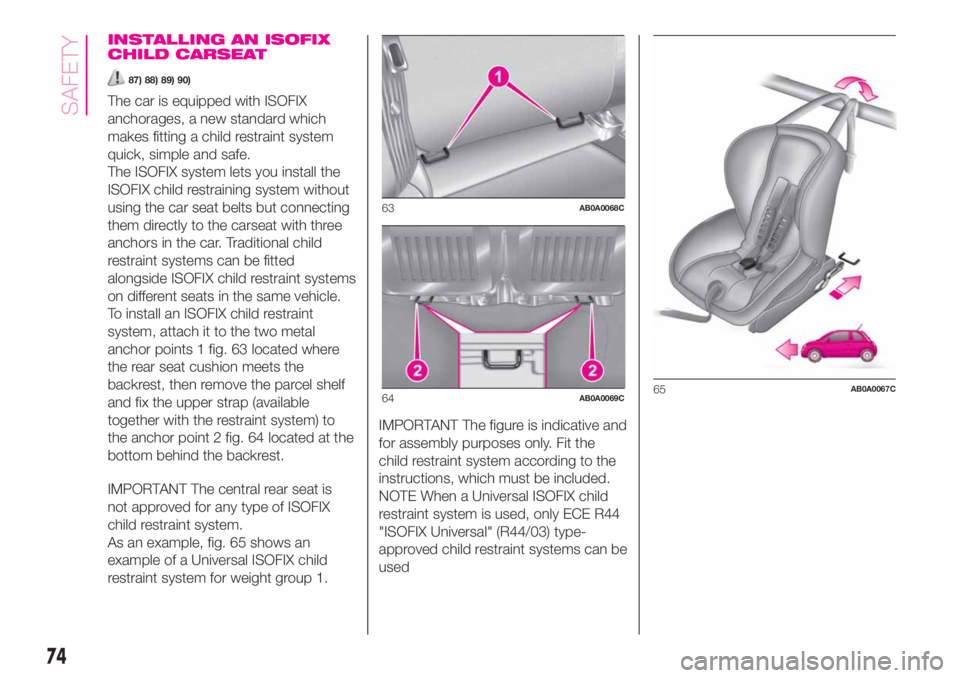
INSTALLING AN ISOFIX
CHILD CARSEAT
87) 88) 89) 90)
The car is equipped with ISOFIX
anchorages, a new standard which
makes fitting a child restraint system
quick, simple and safe.
The ISOFIX system lets you install the
ISOFIX child restraining system without
using the car seat belts but connecting
them directly to the carseat with three
anchors in the car. Traditional child
restraint systems can be fitted
alongside ISOFIX child restraint systems
on different seats in the same vehicle.
To install an ISOFIX child restraint
system, attach it to the two metal
anchor points 1 fig. 63 located where
the rear seat cushion meets the
backrest, then remove the parcel shelf
and fix the upper strap (available
together with the restraint system) to
the anchor point 2 fig. 64 located at the
bottom behind the backrest.
IMPORTANT The central rear seat is
not approved for any type of ISOFIX
child restraint system.
As an example, fig. 65 shows an
example of a Universal ISOFIX child
restraint system for weight group 1.IMPORTANT The figure is indicative and
for assembly purposes only. Fit the
child restraint system according to the
instructions, which must be included.
NOTE When a Universal ISOFIX child
restraint system is used, only ECE R44
"ISOFIX Universal" (R44/03) type-
approved child restraint systems can be
used
63AB0A0068C
64AB0A0069C65AB0A0067C
74
SAFETY
Page 77 of 196
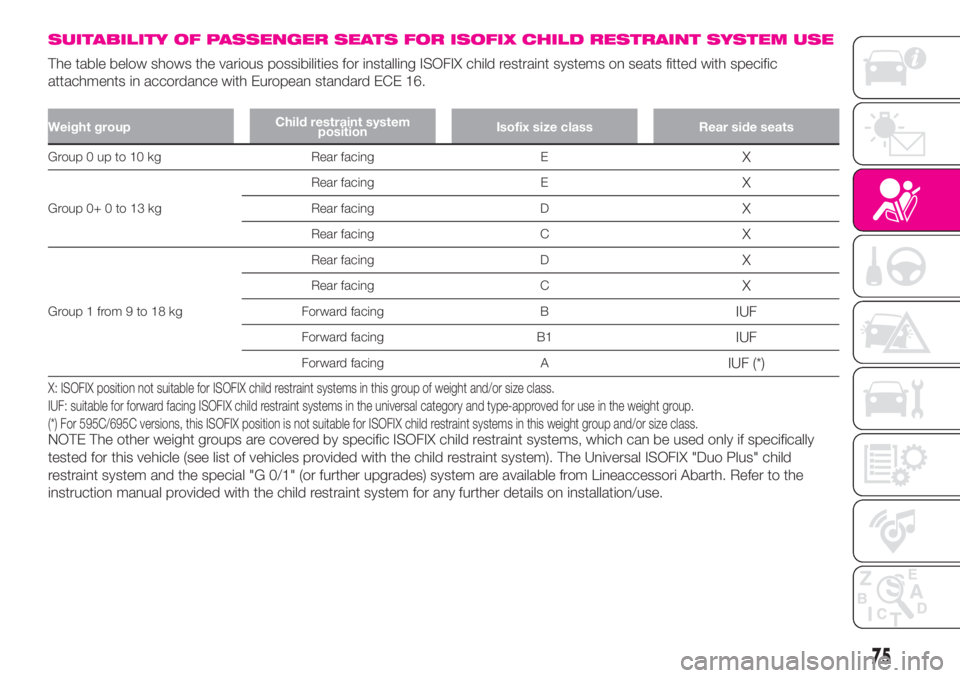
SUITABILITY OF PASSENGER SEATS FOR ISOFIX CHILD RESTRAINT SYSTEM USE
The table below shows the various possibilities for installing ISOFIX child restraint systems on seats fitted with specific
attachments in accordance with European standard ECE 16.
Weight groupChild restraint system
positionIsofix size class Rear side seats
Group 0 up to 10 kg Rear facing EX
Group0+0to13kgRear facing E
X
Rear facing DX
Rear facing CX
Group1from9to18kgRear facing D
X
Rear facing CX
Forward facing BIUF
Forward facing B1IUF
Forward facing AIUF (*)
X: ISOFIX position not suitable for ISOFIX child restraint systems in this group of weight and/or size class.
IUF: suitable for forward facing ISOFIX child restraint systems in the universal category and type-approved for use in the weight group.
(*) For 595C/695C versions, this ISOFIX position is not suitable for ISOFIX child restraint systems in this weight group and/or size class.
NOTE The other weight groups are covered by specific ISOFIX child restraint systems, which can be used only if specifically
tested for this vehicle (see list of vehicles provided with the child restraint system). The Universal ISOFIX "Duo Plus" child
restraint system and the special "G 0/1" (or further upgrades) system are available from Lineaccessori Abarth. Refer to the
instruction manual provided with the child restraint system for any further details on installation/use.
75
Page 78 of 196
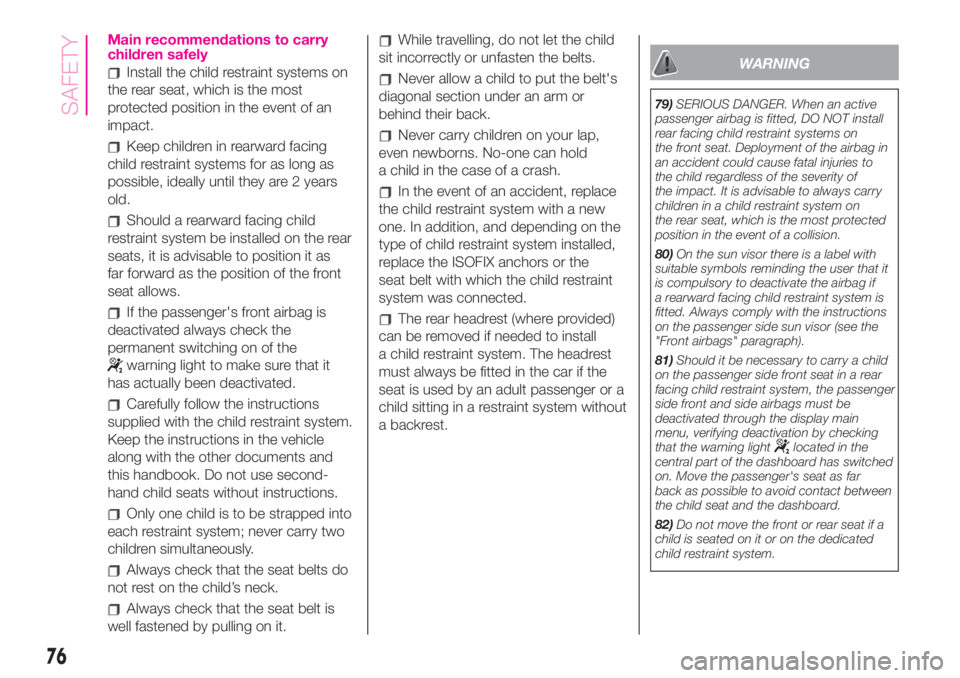
Main recommendations to carry
children safely
Install the child restraint systems on
the rear seat, which is the most
protected position in the event of an
impact.
Keep children in rearward facing
child restraint systems for as long as
possible, ideally until they are 2 years
old.
Should a rearward facing child
restraint system be installed on the rear
seats, it is advisable to position it as
far forward as the position of the front
seat allows.
If the passenger's front airbag is
deactivated always check the
permanent switching on of the
warning light to make sure that it
has actually been deactivated.
Carefully follow the instructions
supplied with the child restraint system.
Keep the instructions in the vehicle
along with the other documents and
this handbook. Do not use second-
hand child seats without instructions.
Only one child is to be strapped into
each restraint system; never carry two
children simultaneously.
Always check that the seat belts do
not rest on the child’s neck.
Always check that the seat belt is
well fastened by pulling on it.
While travelling, do not let the child
sit incorrectly or unfasten the belts.
Never allow a child to put the belt's
diagonal section under an arm or
behind their back.
Never carry children on your lap,
even newborns. No-one can hold
a child in the case of a crash.
In the event of an accident, replace
the child restraint system with a new
one. In addition, and depending on the
type of child restraint system installed,
replace the ISOFIX anchors or the
seat belt with which the child restraint
system was connected.
The rear headrest (where provided)
can be removed if needed to install
a child restraint system. The headrest
must always be fitted in the car if the
seat is used by an adult passenger or a
child sitting in a restraint system without
a backrest.
WARNING
79)SERIOUS DANGER. When an active
passenger airbag is fitted, DO NOT install
rear facing child restraint systems on
the front seat. Deployment of the airbag in
an accident could cause fatal injuries to
the child regardless of the severity of
the impact. It is advisable to always carry
children in a child restraint system on
the rear seat, which is the most protected
position in the event of a collision.
80)On the sun visor there is a label with
suitable symbols reminding the user that it
is compulsory to deactivate the airbag if
a rearward facing child restraint system is
fitted. Always comply with the instructions
on the passenger side sun visor (see the
"Front airbags" paragraph).
81)Should it be necessary to carry a child
on the passenger side front seat in a rear
facing child restraint system, the passenger
side front and side airbags must be
deactivated through the display main
menu, verifying deactivation by checking
that the warning light
located in the
central part of the dashboard has switched
on. Move the passenger's seat as far
back as possible to avoid contact between
the child seat and the dashboard.
82)Do not move the front or rear seat if a
child is seated on it or on the dedicated
child restraint system.
76
SAFETY
Page 79 of 196
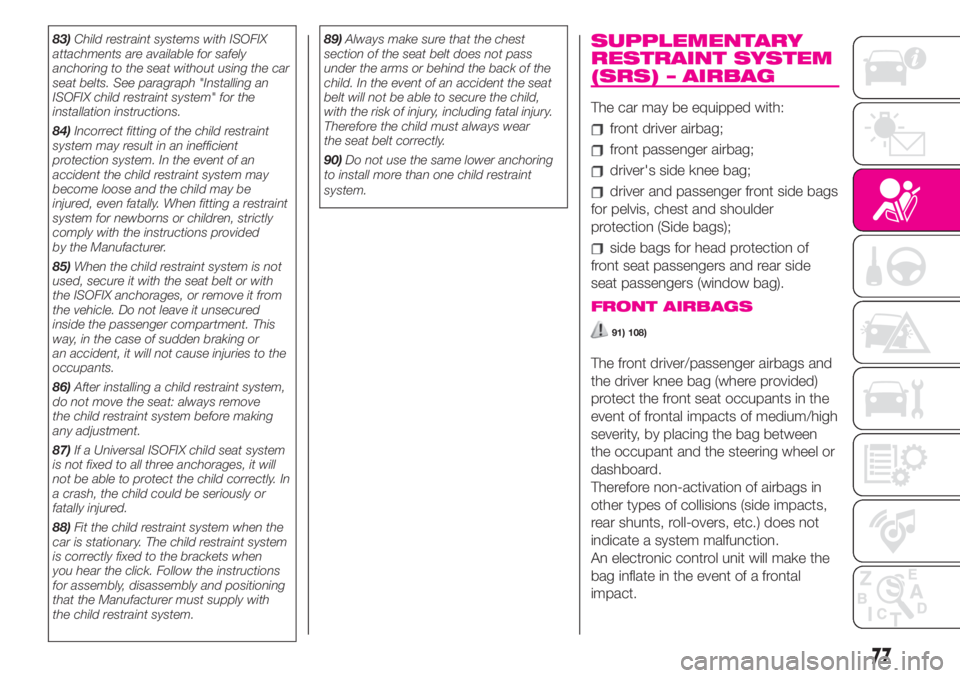
83)Child restraint systems with ISOFIX
attachments are available for safely
anchoring to the seat without using the car
seat belts. See paragraph "Installing an
ISOFIX child restraint system" for the
installation instructions.
84)Incorrect fitting of the child restraint
system may result in an inefficient
protection system. In the event of an
accident the child restraint system may
become loose and the child may be
injured, even fatally. When fitting a restraint
system for newborns or children, strictly
comply with the instructions provided
by the Manufacturer.
85)When the child restraint system is not
used, secure it with the seat belt or with
the ISOFIX anchorages, or remove it from
the vehicle. Do not leave it unsecured
inside the passenger compartment. This
way, in the case of sudden braking or
an accident, it will not cause injuries to the
occupants.
86)After installing a child restraint system,
do not move the seat: always remove
the child restraint system before making
any adjustment.
87)If a Universal ISOFIX child seat system
is not fixed to all three anchorages, it will
not be able to protect the child correctly. In
a crash, the child could be seriously or
fatally injured.
88)Fit the child restraint system when the
car is stationary. The child restraint system
is correctly fixed to the brackets when
you hear the click. Follow the instructions
for assembly, disassembly and positioning
that the Manufacturer must supply with
the child restraint system.89)Always make sure that the chest
section of the seat belt does not pass
under the arms or behind the back of the
child. In the event of an accident the seat
belt will not be able to secure the child,
with the risk of injury, including fatal injury.
Therefore the child must always wear
the seat belt correctly.
90)Do not use the same lower anchoring
to install more than one child restraint
system.SUPPLEMENTARY
RESTRAINT SYSTEM
(SRS) – AIRBAG
The car may be equipped with:
front driver airbag;
front passenger airbag;
driver's side knee bag;
driver and passenger front side bags
for pelvis, chest and shoulder
protection (Side bags);
side bags for head protection of
front seat passengers and rear side
seat passengers (window bag).
FRONT AIRBAGS
91) 108)
The front driver/passenger airbags and
the driver knee bag (where provided)
protect the front seat occupants in the
event of frontal impacts of medium/high
severity, by placing the bag between
the occupant and the steering wheel or
dashboard.
Therefore non-activation of airbags in
other types of collisions (side impacts,
rear shunts, roll-overs, etc.) does not
indicate a system malfunction.
An electronic control unit will make the
bag inflate in the event of a frontal
impact.
77